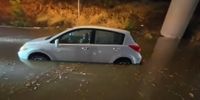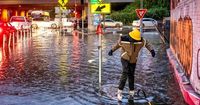Southern California is no stranger to wild weather, but the storm that swept through the region this week was anything but typical. On the night of October 13, 2025, a rare and powerful Pacific storm barreled into Los Angeles and its neighboring counties, unleashing heavy rain, fierce winds, and a very real threat of mudslides and tornadoes. For communities still reeling from the devastation of January’s wildfires, the timing couldn’t have been worse.
By Monday evening, the National Weather Service had issued dire warnings: up to four inches of rain could fall in some foothill and mountain areas, with coastal and valley locations bracing for three-quarters to one and a half inches. Strong winds, gusting between 30 and 55 mph, battered the region. The agency called it a “rare and very potent storm system,” a phrase that sent shivers down the spines of both officials and residents. Ariel Cohen, meteorologist in charge at the Los Angeles office, summed up the sense of uncertainty, saying, “The nature of this system is such that we cannot be certain about exactly when and where these impacts will strike, the exact details until right before they occur at the earliest,” according to FOX Weather and the Associated Press.
For those living in the shadow of recent disaster, the warnings were personal. About 115 homes—mostly in Pacific Palisades and Mandeville Canyon—were placed under mandatory evacuation orders. These neighborhoods, along with others like Malibu, Topanga Canyon, Altadena, and the foothills of the San Gabriel Mountains, were hit hard by the January inferno that killed more than 30 people and destroyed over 17,000 homes and buildings in Los Angeles County. Police officers went door to door, urging residents to leave before the worst of the storm arrived.
“We’re very concerned about the weather,” Los Angeles Mayor Karen Bass said at a Monday night news conference, as quoted by the Associated Press. She emphasized that strike teams, rescue crews, and helicopters were on standby, ready to respond at a moment’s notice.
Evacuation warnings weren’t limited to Los Angeles County. In Orange County, authorities issued voluntary evacuation notices for areas near the Airport Fire burn scar, including Trabuco Creek, Hot Springs Canyon, Bell Canyon, Long Canyon, and Modjeska Canyon. San Luis Obispo County followed suit, ordering shelter-in-place for those living inside the Gifford and Madre Fire burn scars. The Sierra Madre Police Department advised residents in high-hazard locations to evacuate, and a temporary shelter was set up at Hart House Senior Center on Sierra Madre Boulevard for those displaced by the storm.
The threat wasn’t just from rain. The National Weather Service and NOAA’s Storm Prediction Center included Los Angeles in a Level 1 risk area for severe thunderstorms on Tuesday, October 14—the first such warning for the city in more than 17 years. The region even faced the rare possibility of tornadoes. “Some have different elements embedded with them that could at least deliver a little rotation, which would then result in either a downburst or perhaps a tornado. Not saying that’s going to happen, but … the dynamics are there that that could be one of the outliers,” KTLA Meteorologist Henry DiCarlo explained, highlighting the storm’s unpredictable nature.
By early Tuesday, more than 16,000 people had already lost power, according to PowerOutage.us. Streets flooded, trees and power lines toppled, and a section of state Route 27—beginning at the Pacific Coast Highway—was closed as a precaution. In Northern California, the storm’s reach was felt as well: heavy rain caused urban flooding around the San Francisco Bay Area, with video footage showing cars trapped on a flooded Interstate 280 near San Jose. The Sierra Nevadas braced for up to three feet of snow at higher elevations, and CALTRANS closed the Sonora Pass in anticipation.
For many, the trauma of past disasters made the new warnings all the more urgent. In February, neighborhoods scorched by the January fires were hit again by torrential rains, unleashing debris flows and mudslides. In the community of Sierra Madre, water, rocks, and boulders rushed down mountainsides, trapping cars and damaging homes. The Pacific Coast Highway near Pacific Palisades was submerged in several feet of sludge, and a Los Angeles Fire Department vehicle was swept into the ocean by a swift debris flow. The specter of Montecito’s 2018 tragedy—where mudslides killed 23 people after wildfires stripped the hillsides—hung heavy over the region.
As the rain intensified on Tuesday, flash flood warnings and shelter-in-place orders were issued for parts of Santa Barbara and Los Angeles counties. The Los Angeles Fire Department expected evacuation warnings to remain in effect from Monday night through early Wednesday morning. Gladstones Restaurant, a Pacific Palisades landmark, announced it would close on Tuesday, citing past experiences with debris flows at its location.
Despite the chaos, the region’s emergency response was swift and coordinated. Strike teams and rescue crews fanned out across the most vulnerable neighborhoods, while city and county officials worked to keep residents informed. An interactive map of evacuation zones was made available through AlertLA.org, and local news outlets provided up-to-the-minute coverage of road closures, power outages, and emergency shelters.
Elsewhere in the country, severe weather was making headlines, too. Over the weekend, Typhoon Halong brought hurricane-force winds and flooding to western Alaska, sweeping some homes away and leaving one person dead and two missing. In Tempe, Arizona, a sudden microburst and thunderstorm dropped half an inch of rain in just ten minutes, tearing roofs off buildings and knocking out power to thousands.
By late Tuesday afternoon, forecasters predicted the worst of the storm would move north and east of Southern California, with dry conditions and a warming trend expected through Saturday. But for many, the memory of this rare October tempest—and the scars it threatened to reopen—would linger long after the skies cleared.
As the region dries out and surveys the aftermath, the resilience of Southern California’s communities is once again on display. The lessons of past disasters have shaped a response that is vigilant, adaptive, and, above all, determined to protect lives and homes—no matter what the weather brings.






